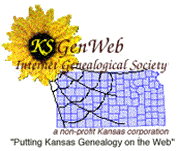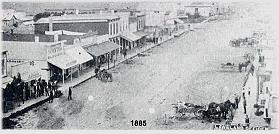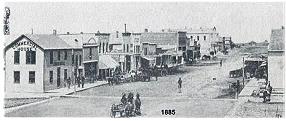 |
City of WaKeeney |
 |
 |
City of WaKeeney |
 |
 |
 |

|
Early History of WaKeeney: (Term Project Presented to Dr. Dobbs in Partial Fulfillment of the requirements for improvement of Instruction in Social Studies Education 312.) BY LYNNE FAVINGER JUNE 1972 Early 1870's-Prairie Before WaKeeney Kansas in the 1879s was vast and empty. By the late 1870's, there were a few Indians--only small bands. There were many wild antelope and gray wolves. The country, previously full of thousands of buffalo, was then covered with buffalo bones. There were very few living buffalo to be seen. But the pioneers took advantage of all that was there. Buffalo chips were used for fuel. The buffalo bones were piled up to mark off places from the main wagon road to a man's home. These bone piles were more important in the eyes of the settlers than the government survey corners were. The only roads were wagon tracks and even these tracks were hard to distinguish. The Kansas Pacific Railroad was just completed and stage coaches traveled through the country. It was this large, desolate country that the Federal Bureau of Immigration was trying to populate. They sent pamphlets in varied languages, as well as representatives, to foreign countries. They also advertised land in eastern United States. The railroads, it was estimated, once owned 20 per cent of the land in Kansas so they too tried to settle the land.
It was through the railroad that WaKeeney was started. Their advertisement
of land caught the attention of James F. Keeney, Chicago. He bought some
land for speculative purposes from the Kansas Pacific Railway Co. in
December, 1877. The cost was $27,732.21. He and his partner, Albert E.
Warren, were looking for wealth in the "Great American Desert." There were
no more than a dozen permanent settlers there when the land was bought. The new town was built between Trego tank and Old Ogallah, or Parks Fort. It is interesting to note the town was started at a water source. Trego tank was the only stopping place for trains in Trego County for many years after the Kansas Pacific Railroad was built in 1868. It had a deep well and a large wind- mill. Trego tank was named in honor of Captain Edgar Poe Trego, who because of his bravery, went beyond the Union picket line at the Battle of Chicamauga and was killed. The first families here were English. Mr. Keeney brought his two brothers, John and Charles. John homesteaded near town and Charles later started a store. A few others came from Chicago at the same time. The first buildings here were the Warren and Keeney Hotel and their ice house. There was also the Warren and Keeney land office. These were the only buildings on the present town site in 1877. C. W. F. Street came to WaKeeney in the fall of 1877 from New York. He ran the hotel for Warren and Keeney and served as sheriff in the early days. He moved his wife and family to WaKeeney in January, 1878. The train stopped at what is now WaKeeney for the first time to let the family off. At that time, the train made stops only to let passengers off at Trego tank, one mile west of the now incorporated city. During the first year that Mr. Street ran the hotel, all the supplies for the hotel were hauled to town on a small flat car behind a hand-car from the town of Hays until a store was opened by Charles Keeney.
Mr. Barclay also accompanied the group. He built a stone home just east of
the hotel. He even had a small greenhouse and a gardener.
The next building after the hotel was built by Charles Keeney. It was
called the Oakes House, named after Oakes Ames, president of the U. P. R. R.
Co. It was built on the corner now occupied by the Skelly oil Co. The first
child born in WaKeeney was born on the second story of that building. Her
name was Viola Frank Keeney. She received that distinguished honor on
Decereber 16, 1878. One of these persons was W. G. Baker from Illinois. He made the decision to move because of his wife's health. She had consumption or tuberculosis. He arrived by train on March 28, 1878. He spent the first night on the floor of the hotel, one of the three buildings there then. He had a timber claim five miles South of town. His family joined him several months later. Mr. Baker was originally from England where he had been a butcher so he started a meat market in WaKeeney. To get ice, Mr. Baker went to Big Springs and hand sawed blocks of ice which he hauled to town on his horse and wagon. Mr. Baker was a very active man and he was elected the second sheriff of WaKeeney. He served in this capacity several times. He was a U. S. Marshal's Deputy in 1884. He raised his family there and stayed in WaKeeney until he died at the age of 98.
In the fall of 1878, the last Indian scare came. There was a campsite
several miles east of WaKeeney. The cook and his dog left camp to hunt for
meat. Soon the dog came back with an arrow in his stomach. Many people fled
eastward, soon returning as the Cheyennes passed to the north. The cook was
found dead several weeks later. On March 2, 1879, the WaKeeney Weekly World was started, making it the oldest established business still in WaKeeney. This newspaper consisted of four pages with a circulation of a few hundred people. The cost was 5c an issue or $2.00 for a yearly subscription. Now the paper is called the Western Kansas World. Two other papers were started that year. One was the Wa-Keeney Kansas Leader and the other was the Globe. Both papers lasted for only a short time. The first school was taught in town that summer. Rev. J. K. Wilson was the superintendent of schools. He had authority over eight districts. That same summer, typhoid and malaria raged with several people dying. The fever was attributed to the water in the town well. The water became unfit for use and water was hauled from the creeks. Drinking water was brought in from a spring. For two or three years following, water tanks were used. Water sold for 20c a barrel and every back door had its own barrel. Soon more wells were drilled, the town well was cleaned out and deepened and the water tank business became a thing of the past. In 1879, Warren and Keeney were anxious to advertise the land they had for sale so they had a grand celebration on July 4th of that year. Governor John P. St. John made a speech from the new railroad station. Seats were made for the occasion. A singer was imported as was an organ. At night there was a fireworks display and a dance. The U. S. Land Office was moved from Hays to WaKeeney in November, 1879. This brought many new people of a high class. Some homesteaded, but others started businesses in town. President Cleveland appointed a man named Beard to a position in the land office. Mr. Beard was a southerner and when he came to WaKeeney, there was no place for his family to live. To solve his problem, he rented the hotel, later known as the American. The building had been vacant but Mr. Beard rejuvenated it and imported a supply of southern negroes to serve as cooks and waiters. He renamed the hotel Cleveland and opened it with a grand ball. The price of each ticket was $5.00. Early writings mentioned many grand balls and other social events where invitations were all artistically designed and people wore the best of clothes. In 1879 and 1880, J. F. Keeney erected the "Keeney Block" which consisted of four rooms on the ground floor with a beautiful Opera House above that, the Mason Lodge room and offices in the front. Many fine things were given in the Opera House. "ParepaRosa" was one among many traveling troupes. "Uncle Tom's Cabin" was also shown. Many home-talent shows were also given. There were many fine bands in the earliest days. WaKeeney even had its own band, the Frontier Cornet Band, which gave a grand ball at the Oakes House in honor of Washington's birthday on February 23, 1886. Mr. Keeney built a large stone home. Years later it was purchased by J. G. Hixson who homesteaded in WaKeeney. The Hixsons lived there until they died. The stone building is one of the few original buildings standing in WaKeeney. However, its status has fallen from that of a comfortable house to a chicken coop.
Trego County was organized on June 21, 1879. The population of the county
was then 1,500. The first county election was held on July 26, 1879.
WaKeeney was growing and the Democratic process was being used. Rev. A. H. Blair of Hays helped bring the first minister, Rev. J. K. Wilson of Cedarville, New Jersey. Rev. Wilson brought his wife and two children in May, 1878. Some relatives, the Cassidays and Simses, also came at that time. Church services were first held in the Warren and Keeney building. The railroad built a stone depot and the old frame depot was bought by the church. The Presbyterians used this depot for nine years until a new church was built. The Methodists formed a church in 1,878. Their first services were held in a small frame building. The first pastor was Rev. J. A. Hoyt who stayed only a year. No minister was available after he left so the Trego County Superintendent of Public Schools, James Stayt, served as pastor. The Methodists built a new church in 1887. In the beginning of 1880, many occupations were found in WaKeeney. Some of these were carpenters, bricklayers, blacksmiths, house painters, wagon makers, shoesmiths, harness makers, tailors, tinners, clerks, washerwomen and dressmakers. All of the jobs for men ranged from $1.50 to $2.00 per day. The women could earn from $.75 to $1.00 per day. Domestic servants were paid from $1.50 to $3.00 per week. On February 3, 1680, at 3 a.m., the fire alarm was sounded. The fire was discovered in the basement of Thorpe's.new building. It could possibly have been extinguished before spreading too far, but Mr. Thorpe said there were several powder kegs in the basement so everyone stayed clear and let the fire take its course. No attempt was made to save anything so the building and all of its contents (including all books and records of the government land office) were destroyed. Ten other frame buildings were also destroyed. The loss was estimated at $50,000. An explosion was never heard so many remarks were made about the new noncombustible explosives. The crop failures of 1879 and 1880 convinced many people that Trego County wasn't the most suitable place for agriculture. Many people moved as rapidly as they came. Mr. Keeney felt the blow and didn't entirely complete the Keeney Block until after 1883. After 1880, all of the businesses started on a downward trend. By 1883 all that remained were four general merchandising stores, a furniture store which also sold boots and shoes, and a grain and coal dealer. WaKeeney's boom was over. In March of 1880, WaKeeney was incorporated into a city. Elections were held the following month in which all the towns- people took a great interest. The most popular passtime in the early 1880's was horseback riding. People, traveled all over the country, as far south as Cedar Bluffs, on picnic'parties. Not only did everyone ride horses, but they did it in style. There were many fine horses in the town. In 1886, a fair was held. There was a race track which was used for two or three summers. In the afternoons and evenings, everyone drove out to the track to test their horses and to watch the others. WaKeeney was a town in which there was much social life. Besides horseback riding and picnics, many nights were spent playing cards or going to church socials. There were chess tournaments and programs of elocution and readings. Every Saturday night during the winter, the Tourist Club met. They were mainly interested in books and history and started the first public library in WaKeeney in 1906. The Masonic Lodge was organized in WaKeeney, June 2, 1881. They met in the Keeney Block. In 1887, the Independent Order of Odd Fellows was organized. There was even a WaKeeney Rifle Club. They advertised on the 4th of July celebration for 20 dozen live pigeons. They offered to pay $1.00 per dozen. With all of the meetings and parties, besides all of the time they spent working hard, everyone managed to get together on July 4th. There was band music, baseball games were played, and many participated in games such as the 3-legged race and potato race. There was lots of food to eat and at night there was always a huge display of fireworks. There was a new tough class of people who followed the departure of the Indians. Most were gold-seekers who stampeded in large numbers to the newly found gold fields in Colorado. They followed the railroad and those who had no money used any means to obtain it. For some time, not a human habitation existed between WaKeeney and Denver except at division points or places where the train crews changed, which were Wallace and Hugo. In these places besides the railroad mess halls and bunk houses, there was nothing but saloons, gambling dens and dance halls. It was almost certain death for any man to wander from the railroad right of way. Dead men lying along the track was not an uncommon sight to see.
WaKeeney saw many of these tramps passing through. In the winter of 1880-81
there was a very bad cold spell. One night, E. W. Blair saw a light in the
church. He looked in the window and saw about 5@O men around the stove. He
got some neighbors together and they went in and talked to the tramps. They
only cautioned them to be careful of the building and the fire. The men
stayed there for a week and no trouble was caused nor damage done. A brickyard was built at that time. Though it only lasted one or two years, some of the brick can be seen at Gibson's Drug Store. The year 1884 found the town with its first bank. The bank was built by John H. March. The first school house was built that year. At that time, the younger children tried to convince their elders a street car line, using horses, was needed from the railroad to the school house. The deed for the land was given to the town by George I. Verbeck. Mr. Verbeck then owned a lumber yard in WaKeeney. If you come to WaKeeney today, you will note there is still a Verbeck Lumber Co. A stipulation was made at one time that, even though owners were changed, the name could never be changed. In 1886, land was still the biggest business in WaKeeney. The Western Kansas World of July 17, 1886, listed about 20 firms: dealers, surveyors, attorneys, land agents, etc, that had to do with the sale of land.
The town was prosperous then and here are some sample ads from the Western
Kansas World: Undertaker - Burial Robes, Cases, Caskets, etc. Mammoth Stocks and Seasonable Prices in Everything. Motto: LIVE AND LET LIVE. Columbus discovered America, but it was left for Marshall and Ufford to discover that what Trego County wanted was more goods for less money. We cleared in the lead on low prices. LIE, STEAL, DRINK AND SWEAR When you lie, let it be in bed, on your claim. When you steal, let it be from bad company. When you drink, drink moderately. When you swear, swear that your Land Agent shall be no other than McKnight and Whittsill, Land and Loans. You are feeling depressed, your appetite is poor, you are bothered with headache, you are fidgety, nervous and generally out of sorts and want to brace up. Brace up, but not with stimulants, spring medicines or bitters, which have for their basis very cheap, bad whiskey, and which stimulates you for an hour and then leave you in worse condition than before. What you want is an alternative that will purify your blood, start healthy action of liver and kidneys, restore your vitality, and give renewed health and strength, Such a medicine you will find in ELECTRIC BITTERS and only 50c a bottle at Dr. A. B. Jones' Drug Store.
Great excitement has been caused in Paris, Texas, by the remarkable
recovery of Mr. J. E. Carley who was so helpless he could not turn in bed or
raise his head; everybody said he was dying of consumption. A trial bottle
of King's New Discovery relieved him. By the time he had taken two bottles
of the Discovery and two boxes of Dr. King's New Life Pills, he was well and
had gained in flesh 36 pounds. Trial bottles of this NEW DISCOVERY FOR
CONSUMPTION free at the Jones' Drug Store. The Protestant Episcopal Church, St. Stephens, was organized in 1889. The services were first held in the Masonic Hall. The name of St. Stephen was only used a short time. Soon after the organization of the church, the members of the congregation decided to change the name to St. Johns. It continued under this name for several years until another change was made. It became known as the Church of the Heavenly Rest, only to be changed back to St. Stephens in later years. By 1890 the population of WaKeeney was 439. The times were very hard in the 90?s and enough people moved away bringing the population down to 394 in 1900. While others were moving, the Russian Germans started settling to the north and west of WaKeeney. This group of people organized the Bethlehem Lutheran Church on October 31, 1897. They first met in the school house and then used the Methodist Church until 1904 when they built their own church. At about the same time, Russian Germans settled south of WaKeeney. They organized the Zion Evangelical Lutheran Church in 1905. They built a church in 1908. This church is still standing and services are held there today.
The first Roman Catholic Masses in WaKeeney were in a private home in 1908.
Because of such a small membership, they met in many different homes until
1934 when Christ the King Church was organized. From then on, no new
churches were organized. From then on, no new churches were organized until
1939.
There were good times and bad times. Much has happened since 1910 but one
thing is for certain. If it wouldn't have been for the great spirit of the
pioneers, WaKeeney would not be in existence today. Mrs. A. H. Blair, an
early pioneer, wrote this about the people of WaKeeney: "This may have been
the 'wild and woolly west' but no more high class - aristocratic - elite -
cultured people were to be found anywhere. There were no old people-all were
young, high spirited, daring anything; optomistic-they knew the world was
theirs; generally met discomforts and trials with gay laughter, for such
were only passing incidents". These were the people who left us the great
heritage we have today.
|
|
|

 |
 |